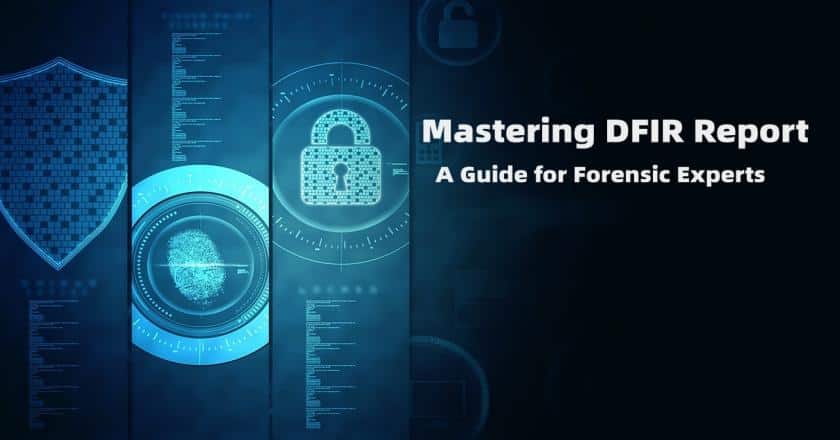Mastering DFIR Report: A Guide for Forensic Experts

-
Content
- Introduction
- Step 1. Preliminary Documentation
- Step 2. Case Overview
- Step 3. Objectives
- Step 4. Evidence Collection
- Step 5. Forensic Analysis
- Step 6. Findings
- Step 7. Conclusion
- Step 8. Recommendations
-
Content
- Introduction
- Step 1. Preliminary Documentation
- Step 2. Case Overview
- Step 3. Objectives
- Step 4. Evidence Collection
- Step 5. Forensic Analysis
- Step 6. Findings
- Step 7. Conclusion
- Step 8. Recommendations
Introduction
In the realm of digital security, DFIR (Digital Forensics and Incident Response) stands as a critical discipline, embodying the methodologies and practices essential for investigating cyber incidents and breaches. At the heart of DFIR, the emphasis on a dfir report cannot be overstated. Such reports are not mere documentation; they are a comprehensive narrative that encapsulates the who, what, when, where, and how of an incident. This thoroughness is paramount, as it not only aids in understanding the event’s intricacies but also in devising effective strategies to mitigate future risks. The crafting of a dfir report is a meticulous process that leverages dfir tools, delves into the dfir meaning, and addresses the question, “what is dfir in cyber security?” It’s a narrative that guides cyber forensics professionals through the maze of cyber threats and security challenges. In essence, a well-prepared dfir report is indispensable in the fields of information security, digital forensics, and forensic cyber security, serving both cyber forensics companies and cybercrime investigator in their quest to safeguard digital assets against the ever-evolving landscape of cyber threats.
Step 1. Preliminary Documentation
The first record of a dfir report establishes the basis for a thorough comprehension of the cyber event that is being looked into. To ensure responsibility and clarity, the case name, “Cyber Incident 2024: A Comprehensive Analysis,” is presented first in this section, followed by the investigator’s information. Important dates are carefully documented, starting with the incident’s discovery and ending with the report’s preparation, giving the inquiry a clear historical framework. The case’s essential elements are condensed into the executive summary, which also includes a synopsis of the investigation’s methodology, the nature of the cyber threat, and a quick rundown of the conclusions. Stakeholders may use this summary as a reference, since it provides information on how the event affected information security and cyber forensics. It emphasizes how crucial digital forensics is to comprehending cyber threats and security, highlighting the function that cybercrime investigators and cyber forensics organizations have in preventing digital vulnerabilities. The dfir report illustrates the crucial role that dfir plays in navigating the complexity of forensic cyber security via this documentation, in addition to addressing what dfir in cyber security is.
Step 2. Case Overview
The main focus of the case is a complex cyber attack that was found within the network of a major financial institution. The event, which came to light on March 15, 2024, concerned illegal access with the intention of obtaining private client information. Given the intricacy of the breach, it was likely the result of a well-coordinated cybercrime organization that used cutting-edge deception techniques and tools to get beyond conventional security measures. The attackers were able to evade information security standards by taking advantage of a weakness in the institution’s email system that had not yet been discovered, according to the preliminary research. Contextual data indicated that a deliberate, well-planned phishing effort served as the antecedent to the attack, imitating authentic communications. Strong cyber forensics skills are vital, as this example highlights the dynamic nature of cyber threats and security. Through an analysis of the incident’s specifics, this dfir study seeks to provide critical insights for improving forensic cyber security protocols, supporting cyber forensics firms and cybercrime investigators in their ongoing fight against cybercrime.
Step 3. Objectives
This inquiry aims to accomplish two goals. First, carefully catalog and examine the techniques and resources used by the assailants, taking into account the extent of the data they have compromised, the points of access they have used, and the length of time they have been in the system. By delving deeply into the details of the occurrence, we can improve cyber forensics techniques and create stronger information security frameworks. The second objective of the dfir report is to function as an all-inclusive record that not only describes the occurrence in detail but also suggests practical measures to prevent such incidents in the future. This study is meant to serve as more than just paperwork; it is meant to inform and direct cyber forensics firms, cybercrime investigators, and forensic cyber security specialists in taking proactive steps to counter cyber threats and security issues. By doing this, the study makes a substantial contribution to the wider discussion about what constitutes good practice in cyber security and encourages the digital forensics community to adopt a culture of constant learning and adaptation.
Step 4. Evidence Collection
The investigation’s evidence collecting phase included a laborious procedure that was painstakingly planned to gather a wide range of digital data. The careful categorization and arrangement of the data was essential to guaranteeing a smooth analysis. Among the important materials gathered were system logs, email exchanges, network traffic statistics, and access records; each provided a distinct perspective that allowed the strategies and actions of the attackers to be identified and comprehended.
The data was meticulously categorized, with distinctions made between categories and sources (e.g., logs vs digital files) and between internal and external communications systems. The review process was made more efficient by this systematic categorization, which made it easier for investigators to sift through enormous volumes of data.
With a focus on maintaining data integrity, the procedure made sure that all of the material was acquired in an original, unaltered condition that could be relied upon for a comprehensive inquiry. This commitment to data protection was essential to correctly interpreting the mechanics of the breach and developing successful defensive tactics.
Not only did this methodical approach to evidence collecting help to acquire data, but it also greatly advanced the field of cyber forensics and strengthened information security protocols by supporting the conclusions of the dfir report. The investigation was able to discover weaknesses, comprehend the attackers’ technique, and suggest strategic adjustments to avert other security breaches because of the careful gathering and preservation of data.
Step 5. Forensic Analysis

A wide range of dfir technologies and approaches are used at the center of this phase. Utilizing digital forensics tools such as Wireshark and FTK facilitates the discovery of hidden data and artifacts on hard drives and memory. Concurrently, SalvationDATA, an integrated digital solution provider, enhances technical operations superbly.
Rebuilding the sequence of events from the first breach to the attackers’ final retreat is made possible thanks in large part to the analysis phase, which also sheds light on the strategies and methods used. After a thorough documentation procedure in which each piece of evidence is meticulously recorded and labeled, the results are combined into an extensive dfir report. This report describes the event and the evidence found, but it also makes important recommendations that improve the organization’s information security and cyber forensics posture.
This thorough analytical method identifies weaknesses and yields useful insights, giving the company the information it needs to strengthen its defenses against upcoming cyber threats and security issues. The significance of a well-executed forensic study in the larger context of cyber security and incident response is highlighted by this systematic methodology.
Step 6. Findings
The many layers of a highly skilled cyber attack, masterminded via a well planned phishing effort, have been revealed by the thorough forensic investigation. This operation took use of a serious zero-day vulnerability in the company’s email system, which allowed for illegal access to a wealth of private client information that included both financial and personal information. We’ve been able to create an accurate chronology of the attackers’ unlawful access by carefully analyzing the digital trail they left behind, which has shown an alarmingly extended presence of almost three weeks prior to discovery.
Comprehensive logs that document unusual activity, a thorough examination of communication patterns bearing the telltale signs of phishing efforts, and concrete proof of unlawful data exfiltration are among the key pieces of evidence that support these conclusions. The complex tactics and plans used by the attackers have been clarified in large part by this body of material, providing a strong basis for the tactical suggestions made in this study.
These disclosures are a sobering reminder of how crucial it is to advance our information security protocols and cyber forensics procedures on a constant basis. The analysis’s findings highlight how important it is to put sophisticated defensive methods into place in order to counteract the widening range of cyber threats and security flaws and make sure the organization’s digital environment is protected from future intrusions.
Step 7. Conclusion
The thorough investigation into the cyber intrusion has clearly defined the methods and extent of the attackers’ activities, highlighting the critical need of strong dfir report standards in the field of cyber forensics. The situation was successfully resolved by closing the exploited vulnerabilities, improving the monitoring frameworks, and raising employee awareness of cyber dangers and security. Also, the inquiry suggests that security assessments be conducted on a regular basis, that state-of-the-art dfir technologies be used, and that staff continue to be trained on the subtleties of information security. These recommendations are crucial because they are meant to strengthen the organization’s defenses against the impending cyber forensics issues and guarantee the security and integrity of the digital assets that fall under its jurisdiction. This progressive strategy, which prioritizes readiness, prevention, and resilience, is a vital first step in creating a security environment where security is naturally proactive rather than reactive and constantly adjusts to the rapidly changing landscape of cyber threats.
Step 8. Recommendations
In order to enhance the fundamental security tactics delineated, it is essential to embrace a more detailed methodology in the execution of a multi-tiered security structure. This entails not just routine software upgrades and patches but also a deliberate reworking of the whole security protocol to include cutting edge threat detection technology and Dfir tools. Improved phishing awareness training for staff members need to develop into a whole cyber security education curriculum that covers the most recent strategies used by online fraudsters. Conducting regular security audits and vulnerability assessments with a more proactive approach is recommended, with the goal of using sophisticated predictive analytics to anticipate possible security vulnerabilities in addition to identifying them. Adopting these strategic, preventive actions is essential to strengthening the organization’s defenses and guaranteeing a resolute posture against a variety of cyber threats. By strategically improving security standards, a proactive cyber security defensive posture is ensured, establishing a new standard for the safety of digital assets.






